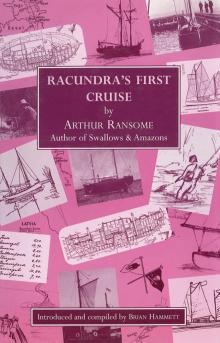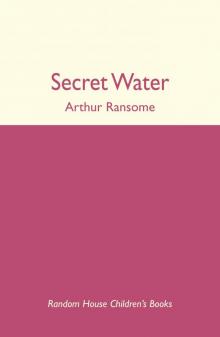- Home
- Arthur Ransome
Swallows and Amazons Page 2
Swallows and Amazons Read online
Page 2
CHAPTER II
MAKING READY
“What care I for a goose-feather bed,
With the sheet turned down so bravely, O?
For tonight I shall sleep in the cold open field
Along with the wraggle-taggle gipsies, O!”
SHIP’S ARTICLES, THOUGH important, are but a small part of making ready for a voyage of discovery. There was a great deal more to do. Luckily, Mother had nearly finished making the tents. She had decided as soon as they had sent off the letters that tents would be wanted if the expedition to the island was allowed, and that if it was not allowed, the next best thing would be a camp on shore. So she had bought the thin canvas and had been working at tent-making every day, while fat Vicky was sleeping and the others were fishing by the boathouse or camping on the Peak of Darien. That night, after Captain John and Mate Susan had followed their crew to bed, Mother had finished both tents.
Next morning, after breakfast, John and Susan, with Mother to help them, Titty to watch, and Roger to get in the way, had put up one of the tents between two trees in the Holly Howe garden. The tents were of the simplest kind. Each tent had a three-cornered piece for the back. The back was sewn to the sides, and a piece of stout rope was stitched to the canvas inside to make the ridge of the roof. The ends of this rope were fastened to two trees, and so held the tent up. No tent poles were needed. Along the bottom edges of the back and sides there were big pockets, to be filled with stones. On rocky ground, where you cannot drive in tent pegs, this is a good plan. At the front of the tent there were loose flaps, joined to the sides, so that they could be rolled up and tied out of the way with two pairs of tapes that worked like the reef points in a sail.
“Properly,” said John, “we ought not to take tents with us. We ought to make a tent out of a sail by hanging it across the yard for a ridge pole, and we ought to hold it up with two pairs of oars, a pair at each end. But one tent would not be big enough and to make two we should want eight oars and two sails, big ones. Swallow has only got one small sail, and two oars. So these tents are much better.”
“They are good enough tents except in a high wind,” said Mother. “Father and I often slept in one when we were young.”
Titty looked gravely at Mother.
“Are you really old?” she said.
“Well, not very,” said Mother, “but I was younger then.”
Mother had bought two square waterproof groundsheets, one for each tent. One of them was spread inside the tent that was being tried.
“You be careful,” said Mother, “to keep the edges of the groundsheet inside the tent, or if it rains you’ll find yourselves sleeping in a puddle.”
Everybody crowded into the tent and sat down. Titty borrowed fat Vicky from Nurse, and brought her in too. Susan shut the flaps of the tent from inside.
“We might be anywhere,” Titty said.
“Next time we put the tent up we shall be on the island,” said John.
“What about mattresses?” said Mother.
“Rugs,” said Captain John.
“Not enough,” said Mother, “unless you want to be like the lady who ran away with the wraggle-taggle gipsies and caught her death of cold.”
“The song doesn’t say so,” said Titty. “It only says she didn’t care.”
“Well, and what happened to Don’t Care?”
“Came to a bad end,” said Roger.
“A cold is a bad end when you are camping, especially on a desert island,” said Mother. “No, we must get some haybags filled for you to sleep on. If you put them on the groundsheets and lie on the top of them, and roll yourselves up in rugs and blankets, you’ll come to no harm.”
Captain John was in a hurry to try the Swallow under sail.
“Let’s go down to the harbour and overhaul the ship,” he said. “We can take her out now, can’t we, Mother?”
“Yes. But I’d like to come with you the first time.”
“Come along. Do. You can be Queen Elizabeth going aboard the ships at Greenwich that were sailing to the Indies.”
Mother laughed.
“It doesn’t matter a bit about your not having red hair,” said Titty.
“All right,” said Mother, “but I think we must leave Vicky with Nurse.”
So they all crawled out of the tent. Fat Vicky was given back to Nurse, and Queen Elizabeth walked down to the boathouse with Captain John of the sailing ship Swallow, Mate Susan, Able-seaman Titty, and the Boy Roger, who ran on ahead with the big key to get the boathouse open.
The boathouse was a stone one, with a narrow quay along each wall inside, and a small jetty sticking out beyond it into the lake.
Roger had got the door open by the time they came to it, though he had had a tough struggle with the rusty lock. He was already inside, looking down on the Swallow. The Swallow was a sailing dinghy built for sailing on a shallow estuary, where the sands were uncovered at low tide. Most sailing dinghies have centreboards, plates which can be let down through their keels, to make them sail better against the wind. Swallow had none, but she had a rather deeper keel than most small boats. She was between thirteen and fourteen feet long, and fairly broad. Her mast lay in her, and beside it, neatly rolled up, were boom, yard, and sail, and a pair of short oars. Her name, Swallow, was painted on her stern.
Captain John and his crew looked at her lovingly. She was already their own ship.
“Better bring her outside and make fast to the jetty while you step the mast,” said Queen Elizabeth. “You won’t be able to get her out if you step the mast while she’s in the boathouse. That beam is too low.”
Captain John went aboard his ship. Mate Susan untied the painter, and between them they brought the Swallow out of the boathouse. Then Susan fastened the painter to an iron ring on the end of the jetty. She too climbed down into Swallow.
“Can I come too?” asked Roger.
“You and Titty and I will wait till they have the sail up,” said Queen Elizabeth. “Give them plenty of room and a free hand. We should only be in the way if we went aboard now.”
“Hullo,” said John, “she’s got a little flagstaff, and there are flag halyards on the mast to hoist it by.” He held up a tiny flagstaff with a three-cornered blue flag on it.
“I’m going to make her a much better flag than that,” said Titty.
“Better take this one to make sure you make yours the same size,” said Queen Elizabeth.
John and Susan had done plenty of sailing, but there is always something to learn about a boat that you have not sailed before. They stepped the mast the wrong way round, but that was set right in a moment.
“She doesn’t seem to have a forestay,” said John. “And there isn’t a place to lead the halyard to in the bows to make it do instead.”
“Let me have a look,” said Queen Elizabeth. “These little boats often do without stays at all. Is there a cleat under the thwart where the mast is stepped?”
“Two,” said John, feeling. The mast fitted in a hole in the forward thwart, the seat near the bows of the boat. It had a square foot, which rested in a slot cut to fit it in the kelson.
“Get the sail ready and hoist it, and make fast there and see how she does,” said Queen Elizabeth.
“I wonder whether the real Queen Elizabeth knew much about ships,” said Titty.
“That Queen Elizabeth was not brought up close to Sydney Harbour,” said Mother.
Susan had got the sail ready. On the yard there was a strop (which is really a loop) that hooked on a hook on one side of an iron ring called the traveller, because it moved up and down the mast. The halyard ran from the traveller up to the top of the mast, through a sheave (which is a hole with a little wheel in it), and then down again. John hooked the strop on the traveller and hauled away on the halyard. Up went the brown sail until the traveller was nearly at the top of the mast. Then John made the halyard fast on the cleats, which were simply pegs, underneath the thwart which served to hold the mast up.
“Is that what those blocks (pulleys) are for hooked to a ring in the kelson close to where the mast is stepped? But they are all muddled up.”
“Isn’t there another ring under the boom, close to the mast?” asked Queen Elizabeth.
“Got it,” said Captain John. “One block hooks to the ring under the boom, and one to the ring in the bottom of the boat. Then it’s as easy as anything to haul the boom down. How’s that?”
“The crinkles in the sail go up and down now, and not across,” said Mate Susan.
“That’s right,” said Queen Elizabeth. “The wind will flatten them out as soon as we start sailing. Can I come aboard, Captain Drake?”
“Please,” said John, “but never mind about being Queen Elizabeth just now.” He was just going to sail Swallow for the first time, and he had quite enough to think about without queens.
Titty, Roger, and Mother climbed down from the jetty into Swallow, as she lay there with flapping sail, ready to start.
“Will you take the tiller, Mother, while I cast off?” said Captain John.
“Not I,” said Mother. “Queen or no queen, I’m a passenger, and I want to see how you manage by yourselves.”
“Right,” said Captain John. “Mister Mate, will you come forward to cast off. Send the crew below to keep their heads out of the way of the boom.”
“Aye, aye, sir,” said Mate Susan. “Get down on the bottom, you two.” The boy and the able-seaman crouched in the bottom of the boat with their heads below the gunwale. John took the tiller. Susan untied the painter from the ring on the pier, put the end of it through the ring, and held it.
“Ready,” she said.
“Cast off,” said the captain, and a moment later Swallow was moving.
“Are we going to the island?” asked the boy.
“No,” said Mother. “It would take too long to go there and back. There’s a lot to be done if you are to start tomorrow morning. Just sail her a little way up against the wind, and then we must run back to deal with haybags and stores, and all the other things you’ll want for the voyage.”
So Swallow’s trial trip was a short one. John sailed her up against the wind, tacking from side to side, and making a little every time, just as Roger had done when he had tacked up the field the day before. Then they turned round for the run home, and raced back with the water creaming round her.
“Your ship is all right, Captain John,” said Mother, when they were once more moored to the jetty, and Susan and John were stowing the sail, and taking the mast down to take the Swallow into the boathouse.
“She’s a beauty,” said John.
The rest of that day was full of business. Mother was stitching haybags out of sacking. Titty had taken the little flagstaff up to the farm, and had cut a triangular flag out of some of the canvas left over from the tents. Mother had drawn a swallow on a bit of paper, and Titty had cut one out of some blue serge that had once been part of a pair of knickerbockers. Then she had put the pattern on the white flag, and cut out a place to fit it. Then she had sewn the edge of the blue swallow all the way round into the place for it in the white flag. When she had done there was a fine white flag with a blue swallow flying across it, and it looked the same from both sides. Then she had fastened it on the little wire flagstaff where the blue flag had been, so that it was ready to hoist to the masthead.
Captain John and the mate were getting together the really important stores and deciding what they could do without. The list had grown very much last night after supper. Roger was kept busy running up and down to the boathouse with all sorts of things that everybody agreed could not be left behind.
The mate’s chief task was fitting out the galley, with the help of Mrs. Jackson, the farmer’s wife, who was lending the things.
“You’ll want a kettle first and foremost,” said Mrs. Jackson.
“And a saucepan and a frying-pan,” said Mate Susan, looking at her list. “I’m best at buttered eggs.”
“And are you really?” said Mrs. Jackson. “Most folk are best at boiled.”
“Oh, well, I don’t count boiled,” said Susan.
Then there were the knives and forks and plates and mugs and spoons to be thought of, and biscuit tins, big ones to keep the food in, and smaller tins for tea and salt and sugar.
“We’ll want rather a big one for sugar, won’t we?” said Roger, who had come in and was waiting for something else to carry down to the boathouse.
“You won’t bake, I don’t suppose,” said Mrs. Jackson.
“I think not,” said Mate Susan.
The pile of things on the kitchen table grew and grew as Susan crossed off the items on her list.
John and Titty came in to show her the new flag and to see how she was getting on.
“Who is going to be doctor?” she asked.
“Surgeon,” said Titty. “It’s always surgeon on board ship.”
“You are,” said John. “You’re the mate. It’s the mate’s job. He comes dancing on to the scene, ‘And well,’ says he, ‘and how are your arms and legs and liver and lungs and bones afeeling now?’ Don’t you remember?”
“Then I ought to take some bandages and medicines and things.”
“Oh, no,” said Titty. “On desert islands they cure everything with herbs. We’ll have all sorts of diseases, plagues, and fevers and things that no medicine is any good for and we’ll cure them with herbs that the natives show us.”
At this point Mother came in and settled the question. “No medicines,” she said. “Anyone who wants doctoring is invalided home.”
“If it’s really serious,” said Titty, “but we can have a plague or a fever or two by ourselves.”
John said, “What about a chart?”
Titty said that as the ocean had never been explored, there could not be any charts.
“But all the most exciting charts and maps have places on them that are marked ‘Unexplored’.”
“Well, they won’t be much good for those places,” said Titty.
“We ought to have a chart of some kind,” said John. “It’ll probably be all wrong, and it won’t have the right names. We’ll make our own names, of course.”
They found a good map that showed the lake in a local guide-book. Titty said it wasn’t really a chart. John said it would do. And Mrs. Jackson said they could take it, but must keep it as dry as they could. That meant another tin box for things that had to be kept dry. They put in besides the guide-book some exercise books for logs and some paper for letters home. They also put in the ship’s library. Titty had found on the shelves in the parlour a German Dictionary left by some former visitor. “It’s full of foreign language,” she said, “and we shall want it for talking with the natives.” In the end it was left behind, because it was large and heavy, and also it might be the wrong language. Instead, Titty took Robinson Crusoe. “It tells you just what to do on an island,” she said. John took The Seaman’s Handybook, and Part Three of The Baltic Pilot. Both books had belonged to his father, but John took them with him even on holidays. Mate Susan took Simple Cooking for Small Households.
At last, when almost everything was piled in the boathouse, just before it was time for Roger and Titty to go to bed, the whole crew went up the path into the pinewood to the Peak of Darien to look once more at the island. The sun was sinking over the western hills. There was a dead calm. Far away they saw the island and the still lake, without a ripple on it, stretching away into the distance.
“I can’t believe we’re really going to land on it,” said Titty.
“We aren’t unless there’s wind tomorrow,” said Captain John. “We’ll have to whistle for a wind.”
Titty and Roger, by agreement, whistled one tune after another all the way home. As they came to the farm the leaves of the beech trees shivered overhead
.
“You see,” said Titty, “we’ve got some wind. Wake up early, and we’ll go out and do some more whistling before breakfast.”
CHAPTER III
THE VOYAGE TO THE ISLAND
“There were three sailors of Bristol City
Who took a boat and went to sea;
But first with beef and captain’s biscuits
And pickled pork they loaded she.”
THACKERAY.
THERE WAS VERY little room in the Swallow when they had finished loading her at the little jetty by the boathouse. Under the main thwart was a big tin box with the books and writing paper and other things that had to be kept dry, like night-clothes. In this box was also a small aneroid barometer. John had won it as a prize at school and never went anywhere without it. Underneath the forward thwart, on each side of the mast, were large biscuit tins, with bread, tea, sugar, salt, biscuits, tins of corned beef, tins of sardines, a lot of eggs, each one wrapped separately for fear of smashes, and a big seed-cake. Right forward, in front of the mast, was a long coil of stout grass rope and the anchor, but it had been found by trying that there was room for the Boy Roger here in the bows as look-out man. Then there were the two groundsheets in which were rolled up the tents, each with the rope that belonged to it. These were stowed just aft of the mast. The whole of the space that was left in the bottom of the boat was filled by two big sacks stuffed with blankets and rugs. Besides all these there were the things that could not be packed at all, but had to go loose, wedged in anyhow, things like the saucepan and frying-pan and kettle, and a big farm lantern. Then there was a basket full of mugs, plates, spoons, forks and knives. There was no room for anything else big except the crew and there on the jetty were four great haybags, stuffed with hay by Mr. Jackson, the farmer, which were to serve as beds and mattresses.
“We shall have to make two trips of it,” said Captain John.
“Or three,” said Mate Susan. “Even with Swallow empty we shall never be able to get more than three of the haybags into her at once.”

 Peter Duck: A Treasure Hunt in the Caribbees
Peter Duck: A Treasure Hunt in the Caribbees Racundra's First Cruise
Racundra's First Cruise Great Northern?
Great Northern? Swallowdale
Swallowdale Swallows and Amazons
Swallows and Amazons Winter Holiday
Winter Holiday Missee Lee: The Swallows and Amazons in the China Seas
Missee Lee: The Swallows and Amazons in the China Seas Pigeon Post
Pigeon Post We Didn't Mean to Go to Sea
We Didn't Mean to Go to Sea The Firebird and Other Russian Fairy Tales
The Firebird and Other Russian Fairy Tales Coot Club
Coot Club The Big Six: A Novel
The Big Six: A Novel Six Weeks in Russia, 1919
Six Weeks in Russia, 1919 Secret Water
Secret Water The Big Six
The Big Six Missee Lee
Missee Lee Peter Duck
Peter Duck The Picts and the Martyrs
The Picts and the Martyrs